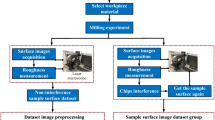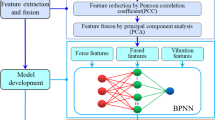Abstract
To achieve the surface roughness of the large-scale machined surface detection rapidly, a surface roughness detection method of “multi-dimensional feature parameters matrix + BP neural network algorithm + automatic acquisition of regions of interest” is proposed. A multi-dimensional feature parameters matrix containing the strong correlation coefficients related to the surface roughness is constructed by extracting various feature parameters of clean image based on the gray-level co-occurrence matrix. The BP neural network model is used to predict the surface roughness with multi-dimensional feature parameters matrix as input. The region of interest in the detected images is extracted consequently by gray value transformation, image filtering, and morphological methods, and the method of “multi-dimensional feature parameters matrix + BP neural network algorithm” is used to detect the surface roughness of the region of interest. The automatic surface roughness detection system is constructed by combining the proposed surface roughness detection methods to analyze the condition of the machined surface and give the surface roughness value rapidly. Compared with experiments, the detecting accuracy and efficiency of the developed system are evaluated regarding the different machined surface features. The results show that the relative errors between the clean image and the interfered image with chips are 6.41% and 5.46%, and the average value of a single detection time is not more than 1.15 s, which can meet the accuracy and time requirements of high-efficiency detection and provides certain technical support for the industrial automated detection.















Similar content being viewed by others
References
Cai YK, Liu ZQ, Shi ZY, Song QH, Wan Y (2016) Influence of machined surface roughness on thrust performance of micro-nozzle manufactured by micro-milling. Exp Thermal Fluid Sci 77:295–305
Leelawattananon T, Thowladda W, Chittayasothorn S (2015) Surface roughness measurement application using multi-frame techniques, vol 2015. 2015 International Conference on Computer Application Technologies (CCATS), pp 86–91
Samtas G (2014) Measurement and evaluation of surface roughness based on optic system using image processing and artificial neural network. Int J Adv Manuf Technol 73(1-4):353–364
Alexander VV, Deng HQ, Islam MN, Terry FL (2010) Non-contact surface roughness measurement of crankshaft journals using a super-continuum laser. 2010 Conference on Lasers and Electro-Optics (CLEO) and Quantum Electronics and Laser Science Conference (QELS). https://doi.org/10.1364/CLEO_APPS.2010.AFA3
Hatefi S, Abou-El-Hossein K (2020) Review of single-point diamond turning process in terms of ultra-precision optical surface roughness. Int J Adv Manuf Technol 106(5-6):2167–2187
Yang B, Yan CX, Zhang JQ, Zhang HY (2016) Refractive index and surface roughness estimation using passive multispectral and multiangular polarimetric measurements. Opt Commun 381:336–345
Yildirim M, Okutucu-Ozyurt T, Dursunkaya Z (2016) A numerical algorithm to determine straightness error, surface roughness, and waviness measured using a fiber optic interferometer. Opt Laser Technol 85:19–29
Lee C (2019) A first review of optical edge-diffraction technology for precision dimensional metrology. Int J Adv Manuf Technol 102(5-8):2465–2480
Pontes FJ, Amorim GF, Balestrassi PP, Paiva AP, Ferreira JR (2016) Design of experiments and focused grid search for neural network parameter optimization. Neurocomputing 186:22–34
Kamguem R, Tahan SA, Songmene V (2013) Evaluation of machined part surface roughness using image texture gradient factor. Int J Precis Eng Manuf 14(2):183–190
Chen C, Guo XM, Ma J, Wang WS (2015) Measurement of surface roughness based on laser angular-speckle correlation method. Laser Technol 39(4):497–500
Chen ST, Feng R, Zhang C, Zhang YY (2018) Surface roughness measurement method based on multi-parameter modeling learning. Measurement 129:664–676
Liu YX, Ma BX, Zhao JY (2018) Surface roughness detection system for workpiece of large machine tool. Instr Techniq Sens 9:71–78
Abdulkadir LN, Abou-El-Hossein K, Abioye AM, Liman MM, Cheng YC, Abbas AAS (2019) Process parameter selection for optical silicon considering both experimental and AE results using Taguchi L9 orthogonal design. Int J Adv Manuf Technol 103(9-12):4355–4367
Mia M, Dhar NR (2016) Prediction of surface roughness in hard turning under high pressure coolant using artificial neural network. Measurement 92:464–474
Beemaraj RK, Sekar MSC, Vijayan V (2020) Computer vision measurement and optimization of surface roughness using soft computing approaches. T I Meas Control 42(13):2475–2481
Chen ML, Hou DM, Wang HJ (2017) Optimal method for image detection based on surface roughness of turning parts. J Appl Opt 38(2):227–230
Jagadish BS, Ray A (2019) Prediction of surface roughness quality of green abrasive water jet machining: a soft computing approach. J Intell Manuf 30(8):2965–2979
Rifai AP, Aoyama H, Tho NH, Dawal SZM, Masruroh NA (2020) Evaluation of turned and milled surfaces roughness using convolutional neural network. Measurement 161:107860. https://doi.org/10.1016/j.measurement.2020.107860
Balasundaram MK, Ratnam MM (2014) In-process measurement of surface roughness using machine vision with sub-pixel edge detection in finish turning. Int J Precis Eng Manuf 15(11):2239–2249
Yi HA, Liu J, Ao P, Lu EH, Zhang H (2016) Visual method for measuring the roughness of a grinding piece based on color indices. Opt Express 24(15):17215–17233
Zhang H, Liu J, Chen SF, Wang WF (2018) Novel roughness measurement for grinding surfaces using simulated data by transfer kernel learning. Appl Soft Comput 73:508–519
Yi HA, Zhao XJ, Tang L, Chen YL, Yang J (2020) Measuring grinding surface roughness based on singular value entropy of quaternion. Meas Sci Technol 31(11):115006. https://doi.org/10.1088/1361-6501/ab9aa9
Liu J, Lu EH, Yi HA, Wang MH, Ao P (2017) A new surface roughness measurement method based on a color distribution statistical matrix. Measurement 103:165–178
Yi HA, Liu J, Lu EH, Ao P (2016) Measuring grinding surface roughness based on the sharpness evaluation of colour images. Meas Sci Technol 27(2):025404. https://doi.org/10.1088/0957-0233/27/2/025404
Ginzburg VB (2009) Flat-rolled steel processes: advanced technologies. CRC Press, Boca Raton
Haralick RM, Shanmugam K, Dinstein I (1973) Textural features for image classification. Stud Media Commu SMC-3(6):610–621
Availability of data and material:
All data generated or analyzed during this study are included in this published article.
Funding
This project was supported by the National Key Research and Development Project 2018YFB2002205), National Natural Science Foundation of China (No. 51875319), and Shandong Natural Science Foundation of China (ZR2020ZD05).
Author information
Authors and Affiliations
Contributions
Wei Chen (first author): methodology, validation, formal analysis, investigation, writing original draft. Bin Zou (corresponding author): formal analysis, resources, writing—review and editing. Yishang Li, Chuanzhen Huang: formal analysis. The author’s contribution corresponds their order. All authors read and approved the final manuscript.
Corresponding author
Ethics declarations
Ethics approval
This study does not involve human participants and/or animal studies.
Consent to participate
Not applicable.
Consent for publication
Not applicable. All data in this paper can be published and verified by all authors.
Conflict of interest
The authors declare no competing interests.
Additional information
I would like to declare on behalf of my co-authors that the work described was original research that has not been published previously, and not under consideration for publication elsewhere, in whole or in part.
Publisher’s note
Springer Nature remains neutral with regard to jurisdictional claims in published maps and institutional affiliations.
Rights and permissions
About this article
Cite this article
Chen, W., Zou, B., Li, Y. et al. A study of a rapid method for detecting the machined surface roughness. Int J Adv Manuf Technol 117, 3115–3127 (2021). https://doi.org/10.1007/s00170-021-07733-9
Received:
Accepted:
Published:
Issue Date:
DOI: https://doi.org/10.1007/s00170-021-07733-9




